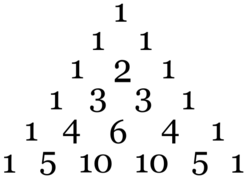Logarithmically concave sequence
In mathematics, a sequence a = (a0, a1, ..., an) of nonnegative real numbers is called a logarithmically concave sequence, or a log-concave sequence for short, if ai2 ≥ ai−1ai+1 holds for 0 < i < n .
Remark: some authors (explicitly or not) add two further conditions in the definition of log-concave sequences:
- a is non-negative
- a has no internal zeros; in other words, the support of a is an interval of Z.
These conditions mirror the ones required for log-concave functions.
Sequences that fulfill the three conditions are also called Pólya Frequency sequences of order 2 (PF2 sequences). Refer to chapter 2 of [1] for a discussion on the two notions. For instance, the sequence (1,1,0,0,1) satisfies the concavity inequalities but not the internal zeros condition.
Examples of log-concave sequences are given by the binomial coefficients along any row of Pascal's triangle and the elementary symmetric means of a finite sequence of real numbers.
References
- ↑ Brenti, Francesco (1989). Unimodal, log-concave and Pólya frequency sequences in combinatorics. Providence, R.I.: American Mathematical Society. ISBN 978-1-4704-0836-7. OCLC 851087212.
- Stanley, R. P. (December 1989). "Log-Concave and Unimodal Sequences in Algebra, Combinatorics, and Geometry". Annals of the New York Academy of Sciences 576: 500–535. doi:10.1111/j.1749-6632.1989.tb16434.x.
See also
 |


